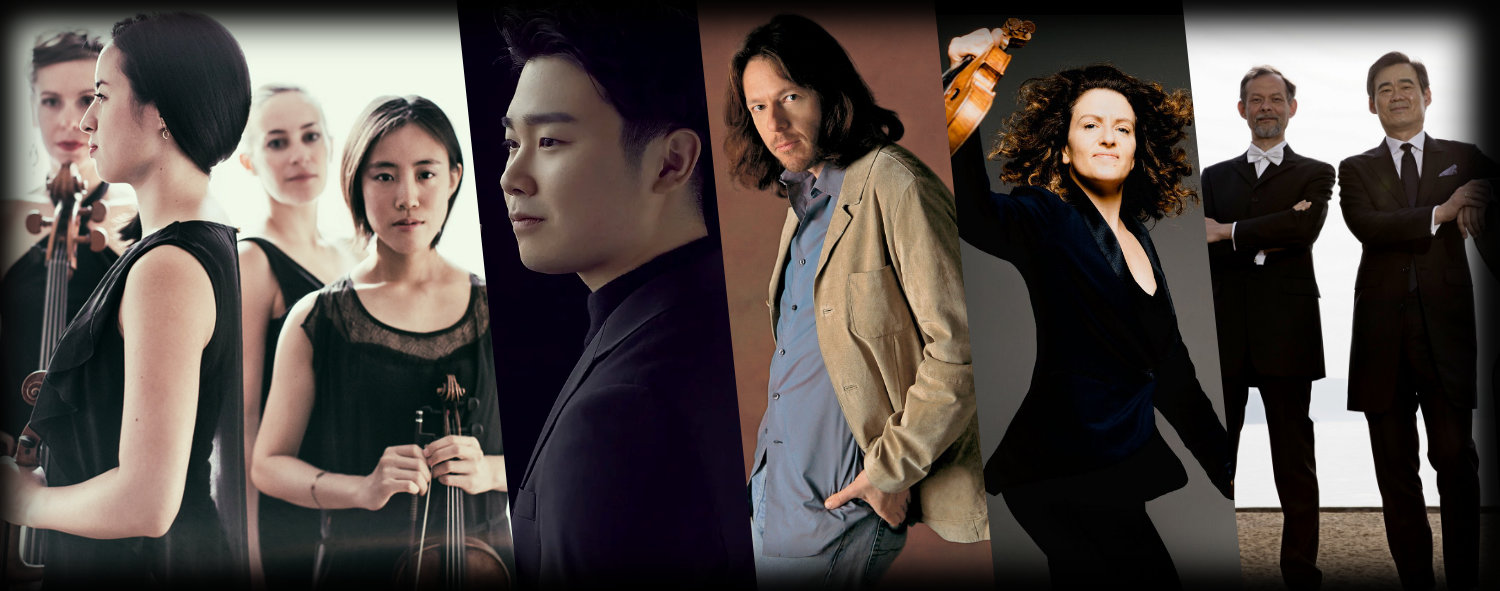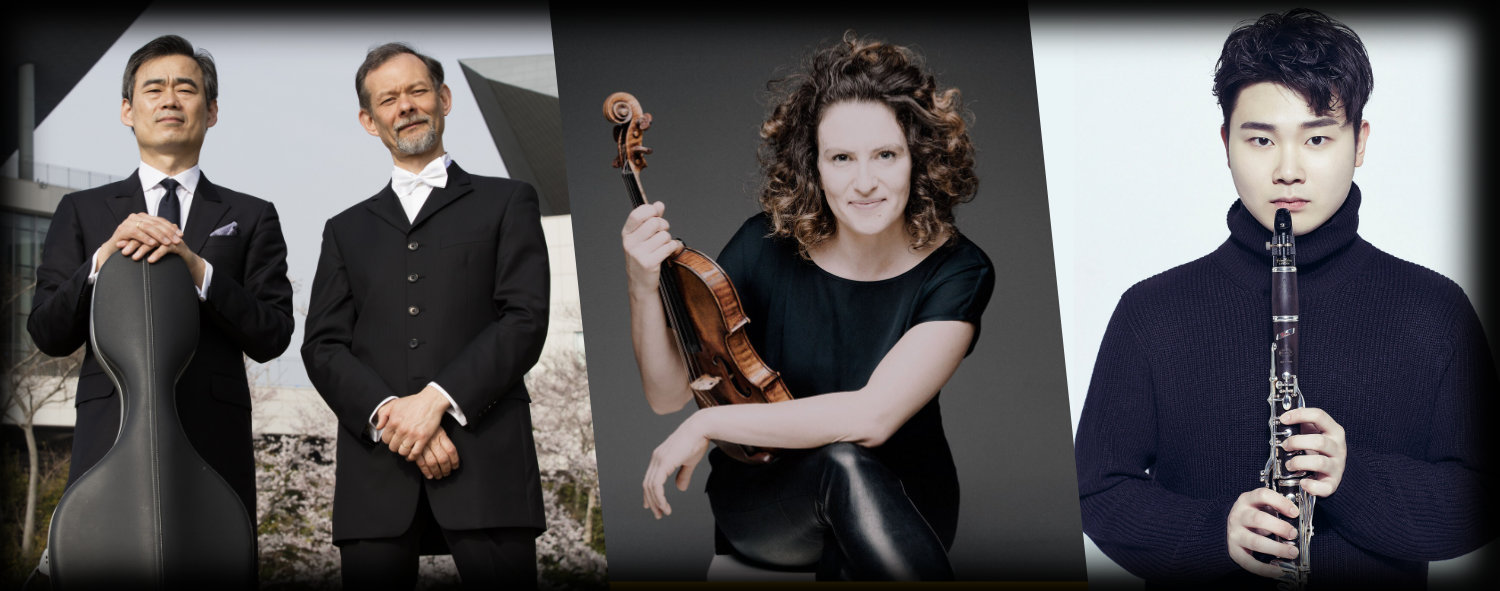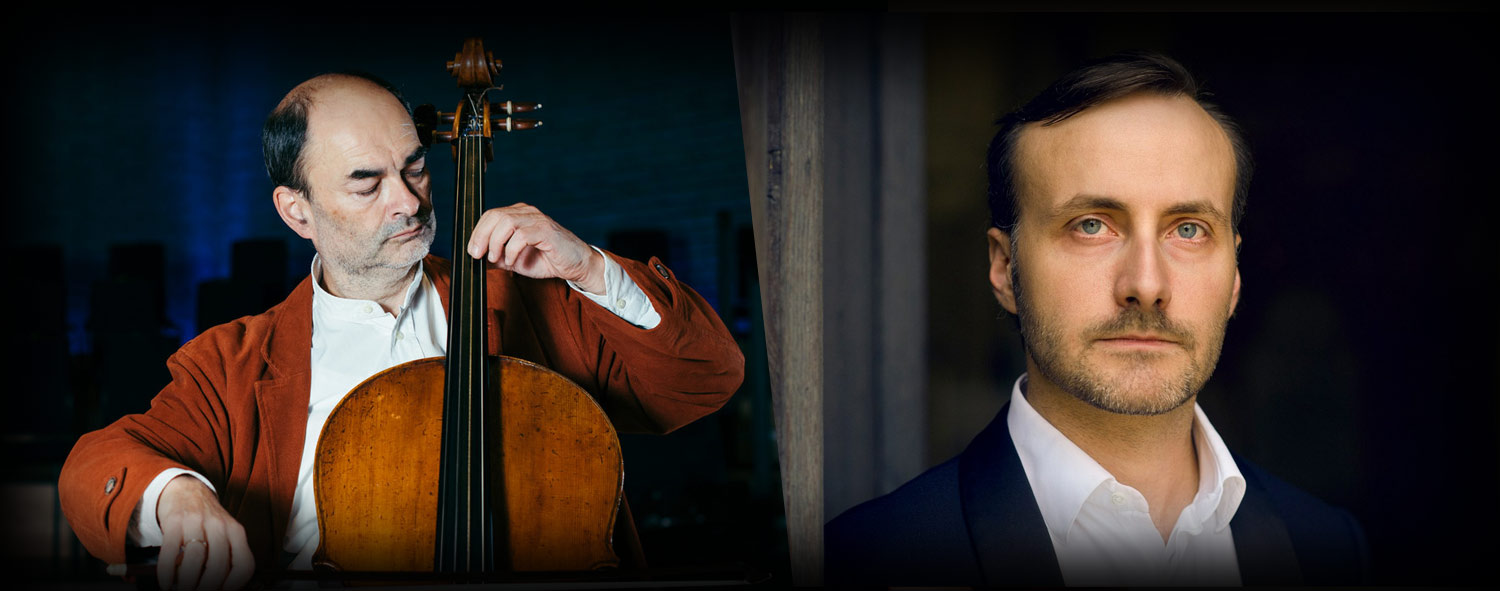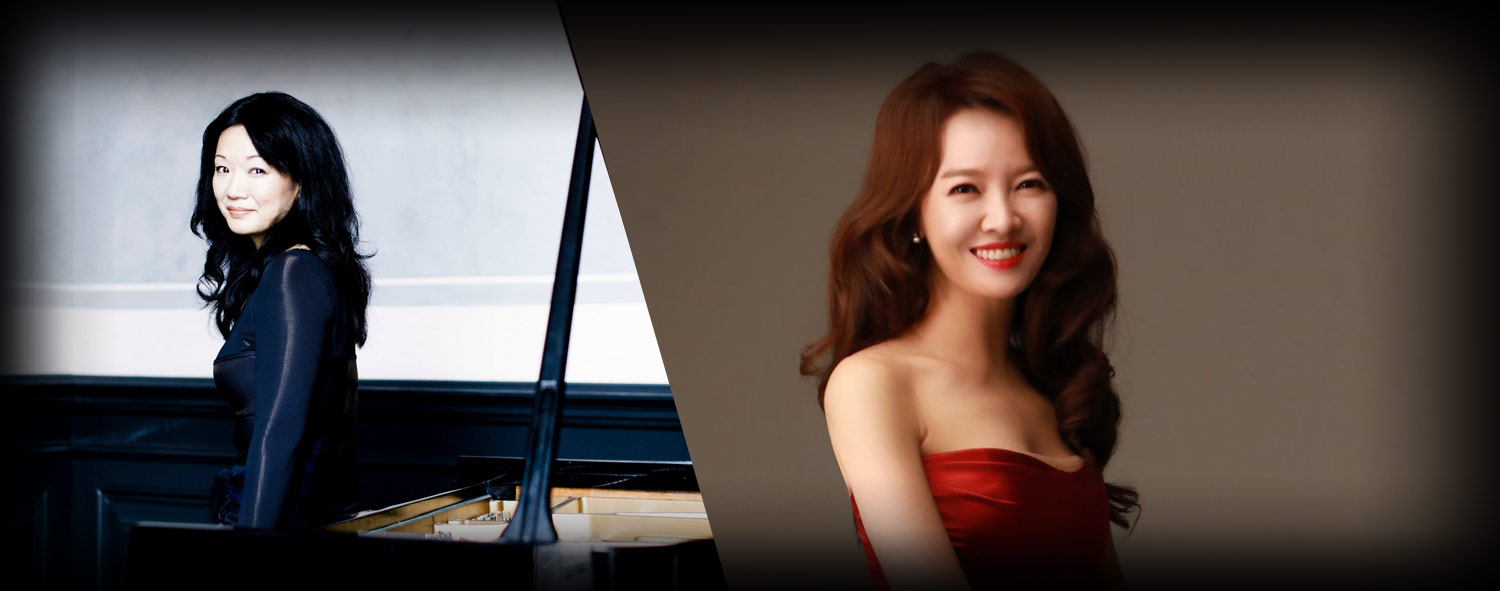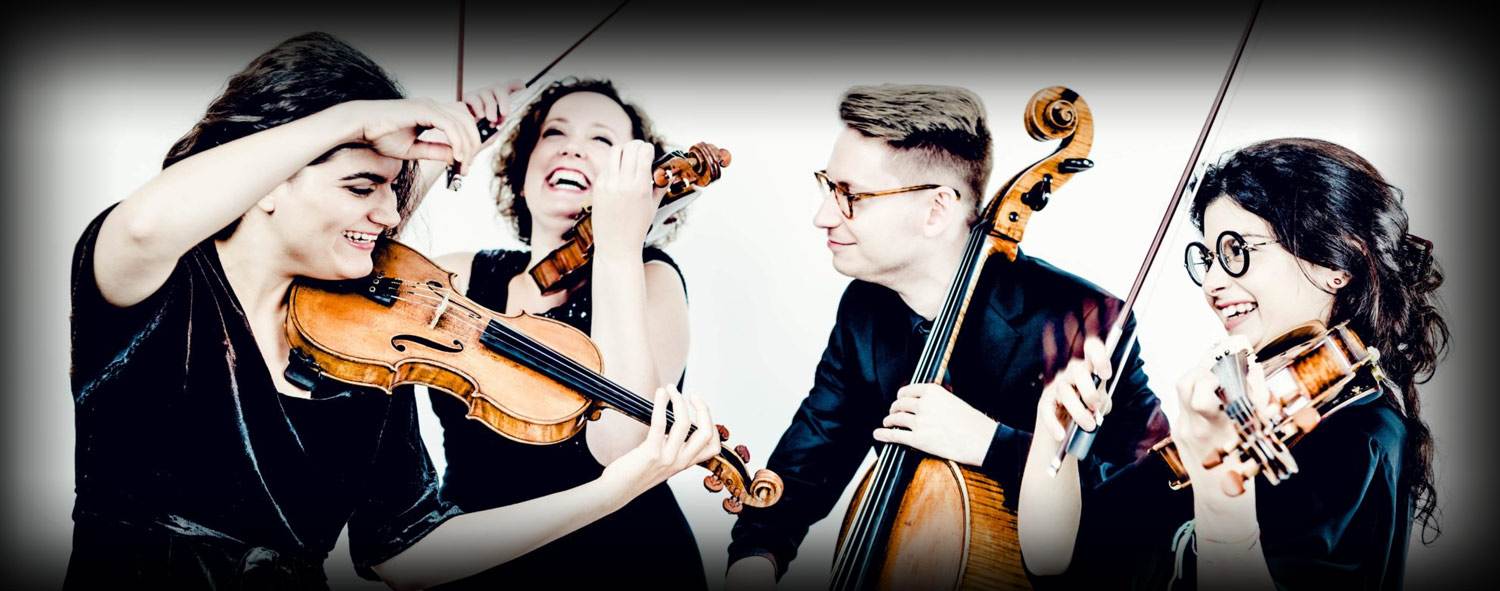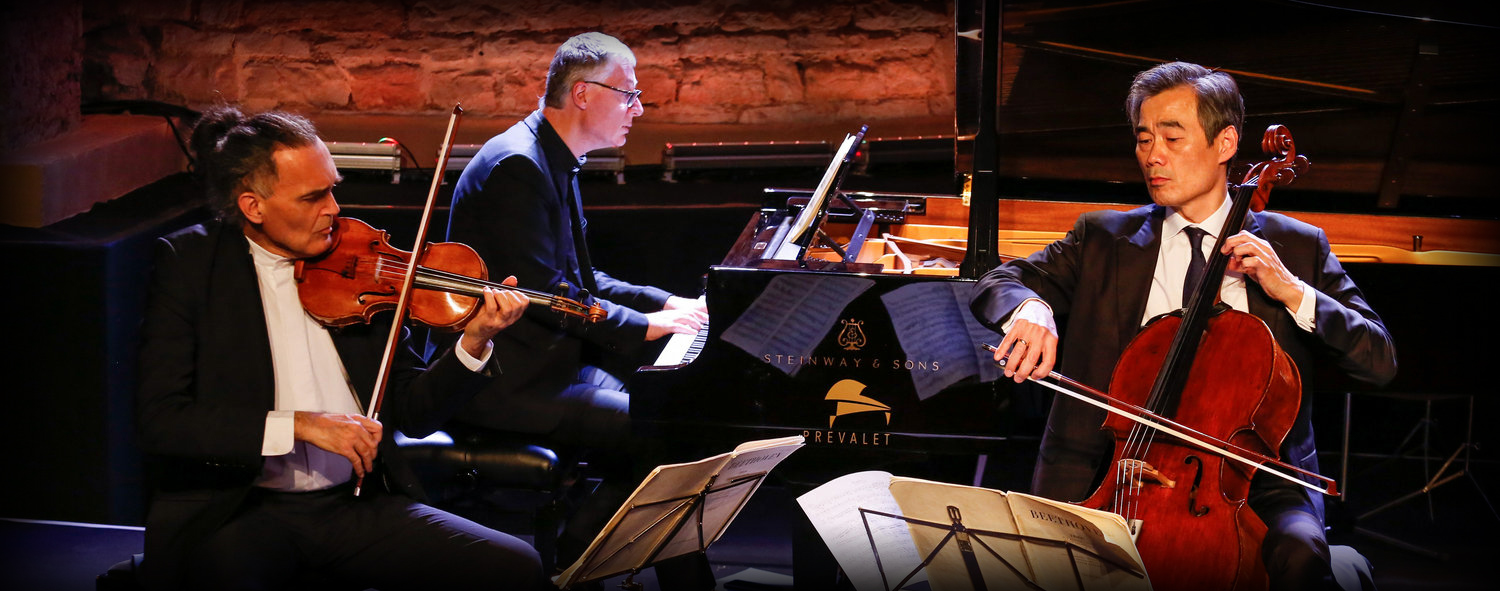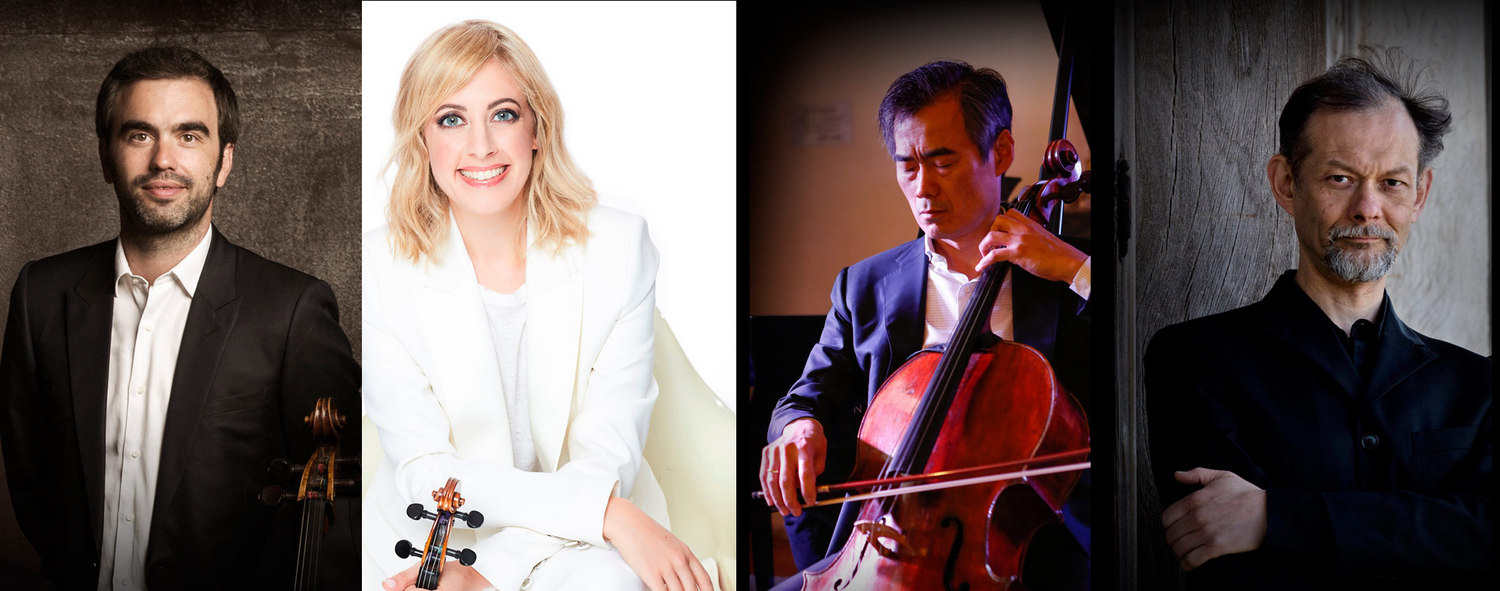Program
Saturday, April 6th – 20h : La Lanterne Magique, Beaune
Quatuor Ardeo, Han Kim, Frank Braley, Liza Ferschtman, Yuko Hara, Sung-Won Yang, Enrico Pace
Mozart, Quintette avec clarinette et quatuor à cordes en La Majeur K. 581
Quatuor Ardeo
Han Kim, clarinet
Clarinettist Anton Stadler performed a number of Mozart’s pieces: he included the Wind Serenade in his own benefit concert in 1784, and played in the premieres of the masonic Maurerische Trauermusik and the Kegelstatt Trio in 1786 before giving the first performance of Mozart’s Clarinet Quintet at a concert of the Tonkünstler-Societät in Vienna on 22 December 1789. While Mozart could find Stadler’s personality trying, he continued to admire his playing, subsequently composing for him the Clarinet Concerto (1791) and a prominent part in arias from the opera La clemenza di Tito (1791).
Of all the works Mozart composed for Stadler, probably only the Quintet was intended for his new type of clarinet, which had more chromatic keys and an extended lower range. Mozart explores this in the clarinet’s fast-moving figuration of the first movement. The strings are muted in the Larghetto, providing a gentle undulating accompaniment to the clarinet’s soulful melody before a dialogue begins with the violin. The Minuet features two trios, the first for string quartet alone and in a minor key; in the second the clarinet returns, as does the major mode. The final movement is a set of theme and variations, which allows individual members of the ensemble to shine – including the viola in the third variation, the only one which moves to the minor. Brief respite is found in the soaring melodies and filigree of the Adagio section before the main theme returns in a lively coda.
Beethoven, Sonate pour piano No. 14 en do dièse mineur Op. 27 No. 2 ‘Clair de Lune’
Frank Braley, piano
Sonata quasi una fantasia. Beethoven’s description of his fourteenth piano sonata, composed in 1801, signals its improvisatory qualities. From its famous opening onwards it is apparent that classical conventions are being discarded in favour of something in a more romantic spirit. The opening Adagio sostenuto is in sonata form, as might be expected, but meditates on the unusual C-sharp minor tonality and the sound qualities of the keyboard instrument, with Beethoven instructing that the opening should be played throughout with the utmost delicacy and without dampers (Si deve suonare tutto questo pezzo delicatissimamente e sense sordino). The Allegretto moves to the major, with off-kilter rhythms and accents. The finale, Presto agitato, in scale, verve, and virtuosity, is full of Beethovenian tempest.
The nascent romanticism of Beethoven’s music is enhanced by its history. He dedicated the Sonata to his piano student – probably onetime love interest, later good friend – the Countess Giulietta Guicciardi. The nickname for this sonata, ‘Moonlight’, gained currency relatively quickly, becoming a common reference point from the 1830s onwards. Its source was probably fictional: Theodor: eine musikalische Skizze, by German poet and critic Ludwig Rellstab published in the Berliner allgemeiner musikalische Zeitung in 1824 (a journal Beethoven would have known). One musician character describes Op. 27 no. 2 as follows: ‘The lake reposes in twilit moon-shimmer (in dämmerndem Mondenschimmer), muffled waves strike the dark shore; gloomy wooded mountains rise and close off the holy place from the world; ghostly swans glide with whispering rustles on the tide, and an Aeolian harp sends down mysterious tones of lovelorn yearning from the ruins’.
intermission
Brahms Quatuor avec piano No. 1 en Sol mineur Op. 25
Liza Ferschtman, violin
Yuko Hara, alto
Sung-Won Yang, cello
Enrico Pace, piano
On his first visit to Vienna in autumn 1862 Johannes Brahms, armed with introductions from Clara Schumann and other musician friends, impressed audiences with performances of his Handel Variations op. 24 and his grandly conceived G-minor Piano Quartet op. 25. The opening movement of op. 25 explores a wide range of melodic ideas and harmonic areas in an expanded sonata form. The traditional scherzo or minuet is replaced by an Intermezzo, which begins with an urgent, swaying theme in C minor played by muted strings. Both this movement and the following slow movement use contrast to great effect: particular lyrical or rhythmic ideas characterise each section, their differences highlighted by changes of key.
In the Rondo-finale “alla Zingarese” Brahms introduces the style hongrois. Evocations of Hungarian “gypsy” music had long been popular among classical composers: from the comfort of urban centres such as Vienna, folkish strains, with their associated social and musical liberties, seemed scintillatingly exotic. The rondo theme of op. 25’s finale is characterised by foot-stomping rhythms, melodic embellishments, dynamic accents, and spread chords and repeated notes in the bassline, all of which conveys a dance-band-like energy. The irregular phrases make the melody plunge into its next iteration without pausing for breath. This theme is interspersed with contrasting sections, with include a slower, offbeat, rather proud melody in G major, a lugubrious melody for strings with a touch of the café band, and a virtuoso cadenza for the piano that careers into the wildly foreign key of F-sharp minor. There is even a glance towards a fugue – Brahms, perhaps, nodding to the legacy of Bach and Beethoven – but this quickly dissipates into the final, triumphant return of the main theme.
Sunday, April 7th – 16h30 : Salle St Nicolas, Hospices de Beaune
Enrico Pace, Sung-Won Yang, Liza Ferschtman, Han Kim
Bach – Busoni, Chorale Préludes
- Viens maintenant, Sauveur des païens BWV 659
- Réveillez-vous, le veilleur nous appelle BWV 645
- Je crie vers toi, Seigneur BWV 639
Bach – Siloti
- Prélude en Si mineur BWV 855a du Clavier bien tempéré
- Sicilienne de la sonata pour flute et clavier BWV 1031
Bach – Myra Hess
- Jésus, que ma joie demeure BWV 147
Enrico Pace, piano
‘The absolutely modern does not exist’, wrote Ferrucio Busoni in 1907: ‘only that which arises at an earlier or later moment of time … “Modern” and “old” have always existed’. Busoni’s ten Chorale Preludes (1907-1909) attest to the special and life-long respect he accorded the music of J.S. Bach. Bach’s Eighteen Chorale Preludes themselves proved that ‘“Modern” and “old” have always existed’: in them, sixteenth-century chorale tunes by Martin Luther are transformed into fugues and inventions, Bach simultaneously paying homage to earlier composers such as Buxtehude and Pachelbel as well as to contemporary trends such as the Italian concerto. In his reworking of the Bach, Busoni undertook a similar process of melding history with the present: according to Erinn E. Knyt, he aimed to ‘recreate the powerful sound of pipe organs in reverberant cathedrals on the piano’.
Other early twentieth-century musicians were also keen to introduce audiences to Bach. In the era before ‘historically-informed performance’ that meant adapting his keyboard works for the modern piano. Ukrainian-born Alexander Siloti studied and then taught at the Moscow Conservatoire. He was an internationally renowned conductor, an editor, and pianist, who fled Russia in 1917, eventually living and teaching in New York City. His transcriptions of Bach were acclaimed during his lifetime – especially the Prelude in B minor. British pianist Myra Hess’s 1926 arrangement of ‘Jesu, Joy of Man’s Desiring’, the chorale from Bach’s 1723 Advent cantata, Herz und Mund und Tat BWV 147, was similarly celebrated. She played it often on her tours of Europe and the USA. These transcriptions, as always, reveal as much or even more about how they are heard and played by their arranger as they do about Bach.
Beethoven, Sonate pour violoncelle et piano No. 4 en Do Majeur Op. 102 No. 1
Sung-Won Yang, cello
Enrico Pace, piano
Beethoven enjoyed the greatest financial success of his career during the Congress of Vienna in 1814. Several of his works were performed as part of the entertainments laid on for the diplomats and dignitaries determining the future of Europe after the capture of Napoleon. On New Year’s Eve, the Russian ambassador Count Razumovsky’s palace was burnt to the ground: not only did the Count lose a priceless art collection, he disbanded his house quartet. Its cellist, Joseph Linke, retreated to Countess Erdődy’s estate in the village of Jedlesee. Beethoven composed the two Cello Sonatas op. 102 for his old friend Linke, who gave the first performance at the hotel Römischer Kaiser, with Carl Czerny at the piano, on 18 February 1816.
Op. 102 no. 1 originally had the unusual title of ‘Free Sonata’. It consists of two movements: the first begins with an Andante that does not quite seem like an introduction; more a meditation on an idea. The contemplative mood is broken by the rumbustious Allegro vivace. The second movement is in three parts: tension builds through an Adagio introduction but dissipates with the introduction of the beatific Tempo d’andante. A questioning four-note motif becomes the theme of the final Allegro vivace, cello and piano chasing and challenging each other, until then join together in the jubilant last bars.
Intermission
Messiaen, Quatuor pour la fin du Temps
Liza Ferschtman, violin
Han Kim, clarinet
Sung-Won Yang, cello
Enrico Pace, piano
Olivier Messiaen said that among his few consolations during his time as a prisoner of war were pocket scores of Bach’s Brandenburg Concertos and Alban Berg’s Lyric Suite. An officer also gave him music paper, pencils and erasers, which enabled him to continue composing. Messiaen wrote for the other musicians in the camp: cellist Étienne Pasquier, clarinettist Henri Akoka and violinist Jean le Boulaire. The instruments they played might have lacked strings and been out-of-tune, but the prison guards encouraged them to practice every evening. The first performance took place on 15 January 1941, in front of 5000 prisoners from all walks of life.
Messiaen claimed to have begun with the ‘Intermède’ that became the fourth of the eight movements of the Quatuor pour la fin du Temps. He also reused music he had composed for organ or ondes Martinots for the third, fifth and eighth movements. It seems likely that the opening ‘Liturgie de cristal’ was finished last. The full ensemble only plays in the first, second, sixth and seventh movements of the Quatuor pour la fin du Temps; otherwise instruments play in different combinations or alone. Birdsong is featured throughout, clarinet and violin imitating nightingales and blackbirds. Messiaen continued to draw on his interest in plainsong, Indian, and Russian music to explore modes, repeated pitch and chord sequences, and extended rhythmic patterns. Energetic fury in the loud, unison writing of ‘Danse de la fureur, pour les sept trompettes’), precedes the Angel who announces the end of time (‘Fouillis d’arcs-en-ciel, pour l’Ange qui annonce la fin du Temps’). The central, fifth movement for solo cello was entitled ‘Louange à l’Éternité de Jésus’. Its pendant, ‘Louange à l’Immortalité de Jésus’, is a violin solo, marked to be played extrément lent, which draws the quartet to an ecstatic close.
Messiaen quotes from the Book of Revelation in his preface to Quatuor pour la fin du temps, inscribing on the score: ‘in homage to the Angel of the Apocalypse, who raises a hand towards Heaven saying: “There shall be time no longer”’. Messiaen explained to the first audience that ‘this quartet was written for the end of time, not as a play on words about the time of captivity, but for the ending of concepts of past and future: that is, for the beginning of eternity’. Decades later, the composer remembered that he had ‘never … been listened to with such consideration and understanding’.
Thursday, April 20th – 20:00 : Salle St Nicolas Des Hospices
Christophe Coin, Bertrand Cuiller
Christophe Coin, violoncelliste
Bertrand Cuiller, claveciniste
Bach
- Sonate pour viole de gambe et clavecin BWV 1027 en sol majeur
- Toccata pour clavecin BWV 912 en ré majeur
- Sonate pour viole de gambe et clavecin BWV 1028 en ré majeur
- Suite No. 2 pour Violoncelle Seul BWV 1008
- Sonate pour viole de gambe et clavecin BWV 1029 en sol mineur
Friday, April 21st – 20:00 : La Lanterne Magique, Beaune
Momo Kodama, Sunhae Im
Momo Kodama, piano
Sunhae Im, soprano
Mozart
Sonate en ré majeur KV 576 pour Piano
(Momo Kodama)
Lieder :
- An Chloë
- Das Lied der Trennung K.519
- Sehnsucht nach Frühling K.596
- Das Veilchen K.476
- Abendempfidung an Laura K.523
(SunHae Im, Soprano – Momo Kodama, Piano)
Sonate en si bémol majeur KV 333
Arie :
- “Giunse al fin.. Deh vieni non tardar” from “Le nozze di Figaro”
- “Una donna a quindici anni” from “Così fan tutte”
- “Zeffiretti lusinghieri” from “Idomeneo”
- A. Adams “Ah! vous dirai-je, maman” from 12 Variation KV265
(Momo Kodama)
Saturday, April 22rd – 20:00 : La Lanterne Magique, Beaune
Quatuor Chaos
Quatuor Chaos
Susanne Schäffer, violin
Eszter Kruchió, violin
Sara Marzadori, alto
Bas Jongen, cello
- Beethoven op 18 no.2 in g major
- Beethoven Grosse Fuge op 133.
- Beethoven op 130 in in b♭ major
Sunday, April 23rd – 16:30 : La Lanterne Magique, Beaune
Trio Owon
Trio Owon
Olivier Charlier, violin
Sung-Won Yang, cello
Emmanuel Strosser, piano
Schubert
- Trio en si bémol majeur op. 99
- Notturno pour trio avec Piano en mi bémol majeur D. 897
- Trio en mi bémol majeur op. 100
Thursday, April 21st, 20h : La Lanterne Magique, Beaune
Full Solo “Improvisations sur Beethoven”
BEETHOVEN AT NIGHT
PAUL IMPROVISES FROM CAPTIVATING MOOLIGHT SONATA, ODE TO JOY, THE 2ND MVT OF THE 7TH SYMPHONY, PLUS NEW COMPOSITIONS DEDICATED TO LUDWIG. THIS PROGRAM WAS CREATED DURING LA FOLLE JOURNÉE DE NANTES IN JANUARY 2020.
Friday, april 22th, 20h : La Lanterne Magique, Beaune
“The crossed paths”
All Schubert program
Quatuor Modigliani
- Quartet No. 12 in C minor D. 703
- Quartet No. 9 in G minor D. 173
Intermission
- Quatuor No. 14 in D minor D. 810 “The maiden and the death”
« Le Quatuor Modigliani fait partie à l’évidence de la cour des grands. » Le Monde
Saturday, April 23rd, 20h : La Lanterne Magique, Beaune
“The monument”
Claire Désert, piano
Marina Chiche, violin
- Clara Schumann : Three Romances for Violin and Piano Op. 22
- Robert Schumann : Fantasiestücke Op. 17
intermission
- L.v. Beethoven : Sonata for Piano No. 17 in D minor Op. 31 No. 2 ‘Tempest’
- L.v. Beethoven : Sonata for Violin and Piano No. 10 in G Major Op. 96
La talentueuse pianiste française Claire Désert est autant reconnue comme une excellente musicienne de chambre que comme une mémorable interprète de Schumann. Ses Novelettes, Davidsbündlertänze and Intermezzi de Schumann comptent parmi les meilleurs enregistrements de ces œuvres : gracieux, colorés et vifs. C’est pourvue des mêmes qualités qu’elle a enregistré son dernier disque consacré aux connections musicales entre Robert Schumann, Clara Schumann et Johannes Brahms. Fanfare Mag, USA – 2011
Sunday, April 24th, 16h30 : Salle St Nicolas des Hospices
“The Spirituality”
Marina Chiche, violin
Laurent Marfaing, alto
Sung-Won Yang, cello
Enrico Pace, piano
Franz. Liszt : Works for Cello and Piano
- Elégie No. 1, S. 130
- Consolation No. 1 and No. 4, S.172
- Romance Oubliée, S. 132
- Consolation No. 6, S. 172
- Lugubre Gondola, S. 134
- Consolation No. 3, S. 132
- Die Zelle in Nonnenwerth, S. 382
- Cantique d’Amour, S. 173 (arr. by Enrico Pace and Sung-Won Yang)
Intermission
Brahms : Piano Quartet No. 3 in C minor Op. 60
Dans la lignée de l’école française de violon, Marina Chiche est l’un des talents les plus prometteurs de la scène musicale internationale.
France Musique
